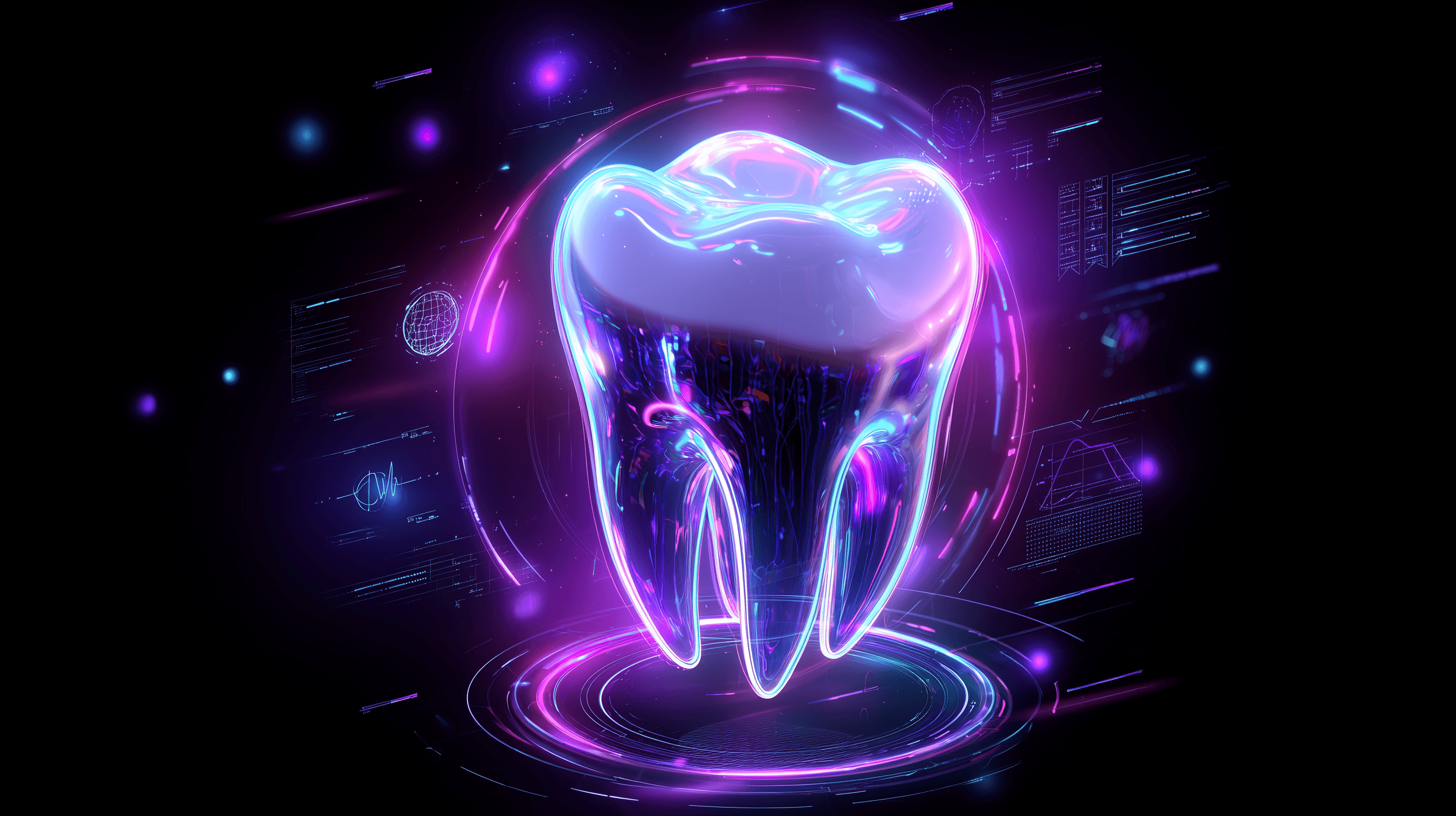Insurance verification can consume between 15 to 30 minutes of staff time per patient when performed manually, creating a bottleneck that affects every dental practice’s operational efficiency and revenue cycle.
This analysis examines the measurable time savings AI verification delivers across different practice sizes, the factors that influence efficiency gains, and the broader financial impact beyond reclaimed labor hours.
Explore Overjet's Dental AI Software
The Manual Verification Time Problem
Manual insurance verification can take 15 to 30 minutes per patient when staff call insurance companies, navigate automated phone systems, wait on hold, log into multiple carrier portals, and manually cross-reference information to update patient records. Dental AI automation can reduce this verification time, potentially of up to 10 to 40+ hours per week depending on practice size and patient volume.
Traditional verification workflows interrupt front desk operations throughout the day. Staff members contact each insurance carrier before appointments to confirm coverage details, often verifying benefits again at check-in to catch recent changes. What AI-powered platforms like Overjet retrieve automatically in seconds takes staff members considerable time to gather manually.
Common Steps In Today’s Workflow
The manual verification process involves several time-intensive tasks. Overjet’s platform speeds up insurance verification with code-level detail, direct payer data feeds, and minimal staff involvement.:
Calling insurance carriers: Staff navigate automated phone menus and wait on hold, often 10 to 15 minutes per call, to reach a representative who can confirm patient eligibility
Logging into payer portals: Practices maintain login credentials for dozens of insurance websites, each with different interfaces and data formats requiring manual navigation
Cross-referencing patient information: Staff compare insurance data against practice management system records, checking for discrepancies in coverage dates, deductibles, and benefit limitations
Documenting verification details: Team members manually enter findings into patient charts, creating opportunities for transcription errors that lead to claim denials
Average Minutes Per Patient By Task
Phone-based verification typically consumes the largest portion of staff time, with hold times alone averaging 8 to 12 minutes per carrier contact. Portal logins add another 3 to 5 minutes as staff locate the correct website, enter credentials, and navigate to the eligibility section. Data entry and documentation require an additional 4 to 6 minutes to ensure accurate record-keeping across systems.
Overjet supports 300+ payers with code-level detail and treatment history, and provides direct data feeds from payers and automated retrieval from payer portals.
Average Minutes Saved With AI Eligibility Checks
AI dental verification platforms perform eligibility checks in seconds rather than the 15 to 30 minutes required for manual processes. The automation queries insurance databases simultaneously across multiple carriers, retrieves current benefit information, and updates patient records without human intervention. This efficiency gain allows practices to verify coverage for every scheduled patient without overwhelming staff capacity.
The time savings scale directly with patient volume. A practice seeing 30 patients daily could potentially save roughly 7.5 hours of verification work each day when automation reduces per-patient time from 15 minutes to 90 seconds. Over a typical workweek, this could translate to nearly 40 hours of reclaimed staff productivity that can be redirected toward patient communication, treatment coordination, and revenue-generating activities. (Disclaimer: time-savings may vary)
Benchmarks For Solo Practices
Smaller practices processing 20 to 40 verifications daily typically recover 10 to 15 hours per week through AI automation. The time savings often allow a single front desk staff member to manage verification alongside other responsibilities without requiring dedicated personnel for insurance tasks. Solo practitioners frequently report that automation eliminates the need to arrive early or stay late to complete verification backlogs.
Benchmarks For Multi-Site Groups
Dental support organizations and multi-location practices processing 200+ claims monthly see proportionally larger efficiency gains. They could potentially save up to 40 to 50 hours weekly across their staff. Overjet partners with large dental organizations to standardize AI verification across networks, creating consistent workflows and reducing the training burden when employees transfer between locations. These organizations benefit from centralized reporting that tracks verification completion rates and identifies coverage issues across their patient population.
Insurer Call-Center Data Points
Eliminating phone-based verification removes the most unpredictable time variable from the process, hold times that range from 2 minutes to over 30 minutes depending on carrier call volume. Dental AI platforms access the same eligibility databases that insurance representatives use, but without queue delays or business hour restrictions. This 24/7 access means verification occurs during off-hours, ensuring data is current when patients arrive for morning appointments.
Factors That Influence Time Savings In Dental Practices
Several variables affect how much efficiency a practice gains from AI dental insurance verification. Understanding the factors helps practices set realistic expectations and optimize their implementation approach.
Claim Volume And Payer Mix
High-volume practices with diverse insurance panels usually see the most dramatic time savings because they process more verifications daily and deal with a wider range of carrier portals. Practices accepting 20+ different insurance plans particularly benefit from automation since staff would otherwise maintain familiarity with numerous payer systems. Even practices with lower patient volume experience significant relief when dental AI handles the verification workload during busy periods or staff absences.
Practice Management Software Integration
Seamless connectivity between AI verification platforms and existing practice management systems maximizes efficiency by eliminating double data entry. Overjet integrates with leading dental PMS platforms to automatically populate patient records with verified eligibility data, reducing the risk of transcription errors that cause claim denials. Practices using integrated solutions report faster adoption rates because staff don’t need to learn new interfaces or modify established workflows significantly.
Staff Adoption And Utilization Rates
Full realization of time savings depends on staff consistently using the AI platform rather than reverting to manual verification methods. Practices achieve optimal results when they establish clear protocols for when and how the system performs verification checks. Training teams to trust automated data, while maintaining spot-check procedures for unusual cases, accelerates the transition from manual to AI-powered workflows.
Calculating FTE And Payroll Impact
Quantifying time savings in terms of full-time equivalent staff helps practice administrators understand the financial implications of AI dental insurance verification. This calculation provides a framework for evaluating return on investment and making staffing decisions.
1. Determine Baseline Labor Hours
Start by tracking how many hours your current staff dedicates to insurance verification each week, including time spent on phone calls, portal logins, and documentation. Many practices discover they’re allocating 20 to 30 hours weekly to verification tasks, equivalent to half a full-time employee’s schedule.
2. Apply Verified Time-Savings Percentages
Using conservative estimates, calculate the hours you’ll recover by reducing verification time significantly, on average about 60%. A practice currently spending 25 hours weekly on verification would reclaim approximately 17.5 hours after automation, representing significant capacity for other activities. The recovered hours can support expanded patient scheduling, enhanced treatment coordination, or reduced overtime costs.
3. Convert Hours To Annual Payroll Dollars
Multiply weekly time savings by your average front desk hourly rate and 52 weeks to determine annual payroll impact. A practice saving 17.5 hours weekly at $20 per hour realizes $18,200 in annual labor value, resources that can offset technology costs or fund other practice improvements.
Secondary Gains: Fewer Denials And Faster Payments
Beyond direct time savings, AI dental insurance verification improves revenue cycle performance by ensuring accurate eligibility data before treatment begins. The accuracy improvements eliminate costly rework for billing specialists who would otherwise correct and resubmit rejected claims.
Denial Rate Reduction Benchmarks
Eligibility-related denials, such as terminated coverage, incorrect subscriber information, or exhausted benefits, represent a significant portion of initial claim rejections that AI verification prevents. Real-time eligibility checks catch coverage lapses before treatment occurs, allowing practices to collect payment at the time of service rather than pursuing patients for balances after insurance denial. Overjet’s platform flags potential coverage issues and provides clear documentation that supports informed financial conversations with patients.
Days Sales Outstanding Improvement
Accurate upfront verification accelerates payment cycles by reducing the time between service delivery and reimbursement. Faster payment improves cash flow predictability and reduces the administrative burden of accounts receivable follow-up, creating a more efficient revenue cycle overall.
Implementation Timeline And Training Needs
Most practices complete AI verification implementation within three weeks. The phased approach allows teams to build confidence gradually while maintaining existing workflows as backup during the transition period.
Week 1: System Integration
Technical setup involves connecting the AI platform to your practice management system and configuring verification parameters to match your scheduling and documentation preferences. IT teams or vendor support staff typically handle the integration, which requires minimal disruption to daily operations. Overjet’s implementation specialists work directly with practices to ensure smooth data flow between systems and verify that eligibility information populates correctly in patient records.
Week 2: Staff Credentialing
Training sessions introduce front desk staff to the AI platform interface and establish protocols for reviewing automated verification results. Most platforms require minimal training, often just 1 to 2 hours, because they work invisibly in the background. Staff learn how to interpret verification reports, identify flags that require attention, and communicate coverage information confidently to patients.
Week 3: Live Parallel Runs
Running manual and automated verification simultaneously for a week allows staff to validate AI accuracy while building trust in the system. This parallel period reveals any configuration adjustments needed and helps teams develop comfort with automated workflows.
Tracking And Maximizing Your Results Post-Launch
Ongoing monitoring ensures that AI verification continues delivering expected efficiency gains and identifies opportunities for further optimization. Establishing measurement practices early creates baseline data for evaluating long-term performance.
Key Performance Indicators To Monitor
Track these metrics monthly to assess AI verification impact:
Verification completion rate: Percentage of scheduled patients with current eligibility data before their appointments
Average verification turnaround time: How quickly the system completes checks after patients schedule
Eligibility-related denial rate: Proportion of claims rejected due to coverage issues that verification catches
Staff time allocation: Hours redirected from verification tasks to other activities
Continuous Improvement Best Practices
Review verification accuracy regularly by spot-checking automated results against carrier information, particularly for complex cases involving multiple insurance plans or specialty coverage. Consider expanding automation to related tasks like benefit breakdowns and prior authorization tracking once your team masters basic eligibility verification.
The Future Of Insurance Verification Efficiency
AI-powered verification represents the first step in comprehensive dental practice automation that continues transforming administrative workflows. As platforms like Overjet expand their capabilities to include treatment planning support, claim submission automation, and predictive analytics, practices redirect even more staff capacity toward patient-centered activities.
Ready to transform your practice’s insurance verification process?
Ready to See Overjet's Dental AI in Action?
Frequently Asked Questions (FAQs)
How does AI handle secondary insurance coordination?
AI systems automatically sequence primary and secondary payer verification, eliminating manual coordination steps and reducing processing delays. The platform identifies coordination of benefits requirements and retrieves coverage details from both carriers simultaneously, ensuring accurate benefit calculations before treatment begins.
What happens if a payer’s portal is offline?
Modern AI platforms maintain backup verification methods and queue requests for automatic retry when systems restore connectivity. Most solutions access multiple data sources for each carrier, reducing dependence on any single portal and maintaining high verification completion rates even during payer system outages.
Can AI verification account for orthodontic lifetime maximums?
Advanced AI solutions track complex benefit structures including lifetime maximums, annual limits, and specialty coverage restrictions across multiple treatment categories. The platform maintains historical benefit usage data and calculates remaining coverage for orthodontic and other specialty treatments that have lifetime or multi-year limitations.
Does AI eliminate front office jobs or change their focus?
AI verification typically redirects staff from repetitive tasks toward patient relationship activities like treatment coordination, financial counseling, and appointment optimization. Practices rarely reduce headcount after implementing automation; instead, they expand services or improve patient communication using the reclaimed staff capacity.








